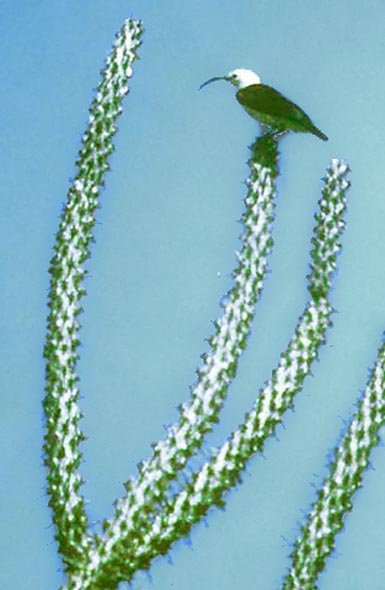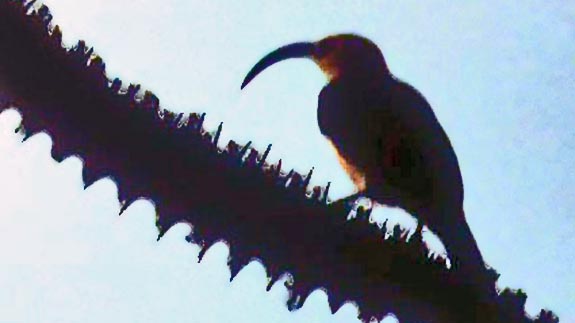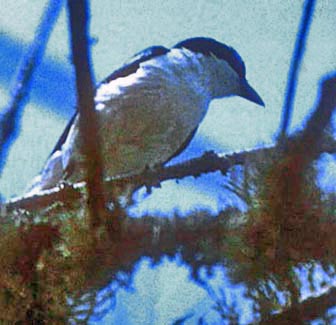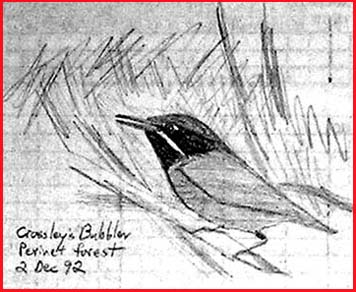| |
VANGAS Vanginae |
- 21 species on Madagascar
- DR personal total: 17 species (81%), 9 photo'd
|
 |

The spiny forest of southwestern Madagascar is one of the world's strangest habitats, dominated by tall, spiky Alluaudia procera trees. Atop one of those trees is one of Madagascar's strangest birds, the Sickle-billed Vanga
(left). It has a white head and underparts and a black mantle; its long
decurved bill, though, may be better seen in the silhouetted shot
(above). These are "the most noisy and character-full members of the
bird community" in the spiny desert (Morris & Hawkins 1998). They
are often in groups of 3 to 10, giving loud "waaah" calls,
like a baby crying. The long, decurved bills are used to "probe into
holes and crevices in dead and live trees, lever off bark, and glean
insects from the surface (Morris & Hawkins 1998).
In
that same forest is another black-and-white vanga with a very short,
wedge-like bill that it uses to strip the bark off dead branches and
tree trunks. When it finds an insect it will batter it against the
wood. This is Lafresnaye's Vanga (below). |
|
|
| Many
of the vangas, including Sickle-billed Vanga, often associate with
other birds in mixed species flocks working through the forest. All the
vangas require woodland of some type — from thick humid jungle to dry
open spiny forest — and so are good indicators of the presence of
native habitat. Several of the vangas are the "core" species of these
foraging flocks. The Lafresnaye's Vanga (above) is different. It does
not join flocks but forages alone or in small single-species flocks.
Its The flight is powerful (the one above right is just taking off)
between foraging sites, and then it works the dead tree from bottom up,
"spending much time to remove bark, often working with head pointed
down" (Langrand 1990). |
 Traditionally,
vangas were considered to be an endemic family to Madagascar, with just
14 species, but the number of species has expanded with recent
discoveries. This island family arose in isolation and birds evolved to
fill numerous niches. Jønsson et al. (2012) provides molecular
evidence that this diversification arose rapidly within the last 10
million years and is as dramatic as the better known (and younger)
diversifications that occured in the Hawaiian Honeycreepers or the
Darwin's Finches of Galapagos Traditionally,
vangas were considered to be an endemic family to Madagascar, with just
14 species, but the number of species has expanded with recent
discoveries. This island family arose in isolation and birds evolved to
fill numerous niches. Jønsson et al. (2012) provides molecular
evidence that this diversification arose rapidly within the last 10
million years and is as dramatic as the better known (and younger)
diversifications that occured in the Hawaiian Honeycreepers or the
Darwin's Finches of Galapagos
All of the vangas prey
on invertebrates or small herps to one degree or another. Some have
evolved heavy wedge-like bills for breaking off bark, like that of Van Dam's Vanga
(right), a species restricted to deciduous forest of the northwest
where it is rare and local. One species fills the niche of a chickadee
(Red-tailed Vanga Calicalius madagascariensis), another that of a nuthatch (the Nuthatch Vanga Hypositta corallirostris
looks so much like a nuthatch that its alternate name is "Coral-billed
Nuthatch), and yet another has a huge casqued bill, recalling
hornbills, and is known as the Helmetbird Euryceros prevostii (it is also the most remote species, restricted to extreme northern Madagascar). |
 Another,
Chabert's Vanga (left) forages with mixed species flocks and sallies
out like a small flycatcher, or glides like a small wood-swallow.
Although difficult to see in this shot, it has bare blue skin around
its eye (like the wattle-eyes of Africa). Another,
Chabert's Vanga (left) forages with mixed species flocks and sallies
out like a small flycatcher, or glides like a small wood-swallow.
Although difficult to see in this shot, it has bare blue skin around
its eye (like the wattle-eyes of Africa).
Taxonomically,
the vangas were thought to be related to African families such as the
helmetshrikes, wattle-eyes and batises (indeed, Sibley & Ahlquist
1990 and Sibley & Monroe 1990 lumped all these groups together) but
most authorities considered them a separate family (e.g., Dickinson
2003). Then newer molecular evidence (e.g., Fuchs 2004) showed that
these closely related groups fall into three different clades: the
batises and wattle-eyes in one group, the traditional bush-shrikes in
another group, and the helmet-shrikes, vangas, and flycatcher-shrikes
in the third group. When I wrote this page initially in 2005, I said
that "These data show that helmet-shrikes and vangas are very closely
related, and it possible that in the long run these two families may be
grouped together." For a time I retained vangas as an endemic family to
Madagascar. But the most recent evidence (Reddy et al. 2012,
Jønsson et al. (2012) is that vangas are best considered a
subfamily of a broader vangid assemblage.
|
However,
what constitutes a vanga has changed recently. The initial 14 was
enlarged by a third, to 21 species (more on that just below). The
newest paper [Reddy et al. 2012] showed that vangas and their close
relatives diverged from their shrike-like relations about 24 million
years ago (mya) and these ancestors reached Madagascar about 20 mya.
Then they rapidly evolved and diversified in bill size, foraging
behavior, and filled niches in previously unused habitats. The vangid
relatives on the continents of Africa and Asia did not diversify nearly
as much, but the lineage leading to the Madagascar vangas —
helmet-shrikes, woodshrikes, Philentoma 'flycatchers' and others — together form a monophyletic group.
 As to the vangas of Madagascar themselves, Yamagishi et al. (2001) found that Tylas Tylas eduardi was indeed a vanga (some had once postulated it was a bulbul) but more surprisingly, they found that birds in the genus Newtonia were also vangas. There are four species — Common Newtonia N. brunneicauda, Dark Newtonia N. amphichroa, Archbold's Newtonia N. archboldi, and Red-tailed Newtonia N. fanovanae
— so this immediately increased the vangas by 28%. Then Cibois et al.
(1999, 2001) did molecular work on other Malagasy endemics and found
many surprising things. One of them is that Crossley's Babbler Mystacornis crossleyi is not a "babbler" at all; it is a vanga (Schulenberg 2003). So is Ward's Flycatcher Pseudobias wardi (Schulenberg
2003, Dickinson 2003). So this brings the vangas in Madagascar to 21
species. [My field sketch of Crossley's "Babbler" is to the right]. As to the vangas of Madagascar themselves, Yamagishi et al. (2001) found that Tylas Tylas eduardi was indeed a vanga (some had once postulated it was a bulbul) but more surprisingly, they found that birds in the genus Newtonia were also vangas. There are four species — Common Newtonia N. brunneicauda, Dark Newtonia N. amphichroa, Archbold's Newtonia N. archboldi, and Red-tailed Newtonia N. fanovanae
— so this immediately increased the vangas by 28%. Then Cibois et al.
(1999, 2001) did molecular work on other Malagasy endemics and found
many surprising things. One of them is that Crossley's Babbler Mystacornis crossleyi is not a "babbler" at all; it is a vanga (Schulenberg 2003). So is Ward's Flycatcher Pseudobias wardi (Schulenberg
2003, Dickinson 2003). So this brings the vangas in Madagascar to 21
species. [My field sketch of Crossley's "Babbler" is to the right].
|
Photos: The Sickle-billed Vanga Falculea palliata was near Ishfay, north of Tulear, southwestern Madagascar, on 20 Nov 1992. The Lafresnaye's Vanga Xenopirostris xenopirostris was in that same spiny forest the same day. The Van Dam's Vanga Xenopirostris damii was photographed at Ankarafantsika in the Ampijoroa Forest on 29 Nov 1992. The Chabert's Vanga Leptopterus chabert was near Perinet, in eastern Madagascar, in mid-Nov 1992. I sketched Crossley's Vanga Mystacornis crossleyi at Perinet on 2 Dec 1992. Photos & sketch © Don Roberson; all rights reserved.
Bibliographic note:
There is no "family book" per se but good photos of all vangas (even
the new ones) are in Morris & Hawkins (1998), and their habitats
covered by Dee (1986). A fine introductions to this (now) subfamily,
with spectacular photos, is in Yamagishi & Nakamura (2009).
Literature cited:
Cibois,
A., E. Pasquet, and T.S. Schulenberg. 1999. Molecular systematics of
the Malagasy babblers (Timaliidae) and Warblers (Sylviidae), based on
cytochrome b and 16S rRNA sequences. Molec. Phylog. Evol. 3: 581-595.
Cibois,
A., B. Slikas, T.S. Schulenberg, and E. Pasquet. 2001. An endemic
radiation of Malagasy songbirds is revealed by mitochondrial DNA
sequence data. Evolution 55: 1198-1206.
Dee, T. J. 1986. The Endemic Birds of Madagascar. Intern. Council for Bird Preservation (ICBP), Cambridge, U.K.
Dickinson,
E.C., ed. 2003. The Howard & Moore Complete Checklist of the Birds
of the World. 3d ed. Princeton Univ. Press, Princeton, N.J.
Fuchs,
J., R.C.K. Bowie, J. Fjeldså, and E. Pasquet. 2004. Phylogenetic
relationships of the African bush-shrikes and helmet-shrikes
(Passeriformes: Malaconotidae). Mol. Phylog. Evol. 33: 428-439.
Harris, T., and K. Franklin. 2000. Shrikes & Bush-Shrikes. Princeton Univ. Press, Princeton, N.J.
Jønsson,
K.A., P-H. Fabre, S.A. Fritz, R.S. Etienne, R.E. Ricklefs, T.B.
Jørgensen, J. Fjeldså, C. Rahbek, P.G.P. Ericson, F. Woog,
E. Pasquet, and M. Irestedt. 2012. Ecologoical and evolutionary
determinants for the adaptive radiation of the Madagascan vangas. PNAS:
1115835109.
Langrand,
O. 1990. Guide to the Birds of Madagascar. Yale Univ. Press, New Haven,
CT. Morris, P., and F. Hawkins. 1998. Birds of Madagascar: A
Photographic Guide. Yale Univ. Press, New Haven, CT.
Reddy,
S., A. Driskell, D.L. Rabosky, S.J. Hackett, and T.S. Schulenberg.
2012. Diversification and the adaptive radiation of the vangas of
Madagascar, Proc. Royal Soc. B 279: 2062-2071.
Schulenberg, T.S. 2003. "The Radiations of Passerine Birds of Madagascar," pp. 1130-1134 in S.M. Goodman & J.P. Benstead (eds.) The Natural History of Madagascar.
Sibley,
C.G., and J.E. Ahlquist. 1990. Phylogeny and Classification of Birds: A
Study in Molecular Evolution. Yale Univ. Press, New Haven, CT.
Sibley, C. G., and B.L. Monroe, Jr. 1990. Distribution and Taxonomy of Birds of the World. Yale Univ. Press, New Haven, CT.
Yamagishi,
S., M. Honda, K. Eguchi, and R. Thorstrom. 2001. Extreme endemic
radiation of the Malagasy Vangas (Aves: Passeriformes). Journal
Molecular Evolution 53: 39-46.
Yamagishi, S., and M. Nakamura. 2009. Family Vangidae (Vangas), pp. 142 –171 in
Handbook of the Birds of the World (del Hoyo, J., A. Elliott & D.A.
Christie, eds). Vol. 14. Lynx Edicions, Barcelona, Spain.
|
|
|





 Traditionally,
vangas were considered to be an endemic family to Madagascar, with just
14 species, but the number of species has expanded with recent
discoveries. This island family arose in isolation and birds evolved to
fill numerous niches. Jønsson et al. (2012) provides molecular
evidence that this diversification arose rapidly within the last 10
million years and is as dramatic as the better known (and younger)
diversifications that occured in the Hawaiian Honeycreepers or the
Darwin's Finches of Galapagos
Traditionally,
vangas were considered to be an endemic family to Madagascar, with just
14 species, but the number of species has expanded with recent
discoveries. This island family arose in isolation and birds evolved to
fill numerous niches. Jønsson et al. (2012) provides molecular
evidence that this diversification arose rapidly within the last 10
million years and is as dramatic as the better known (and younger)
diversifications that occured in the Hawaiian Honeycreepers or the
Darwin's Finches of Galapagos Another,
Chabert's Vanga (left) forages with mixed species flocks and sallies
out like a small flycatcher, or glides like a small wood-swallow.
Although difficult to see in this shot, it has bare blue skin around
its eye (like the wattle-eyes of Africa).
Another,
Chabert's Vanga (left) forages with mixed species flocks and sallies
out like a small flycatcher, or glides like a small wood-swallow.
Although difficult to see in this shot, it has bare blue skin around
its eye (like the wattle-eyes of Africa).  As to the vangas of Madagascar themselves, Yamagishi et al. (2001) found that Tylas Tylas eduardi was indeed a vanga (some had once postulated it was a bulbul) but more surprisingly, they found that birds in the genus Newtonia were also vangas. There are four species — Common Newtonia N. brunneicauda, Dark Newtonia N. amphichroa, Archbold's Newtonia N. archboldi, and Red-tailed Newtonia N. fanovanae
— so this immediately increased the vangas by 28%. Then Cibois et al.
(1999, 2001) did molecular work on other Malagasy endemics and found
many surprising things. One of them is that Crossley's Babbler Mystacornis crossleyi is not a "babbler" at all; it is a vanga (Schulenberg 2003). So is Ward's Flycatcher Pseudobias wardi (Schulenberg
2003, Dickinson 2003). So this brings the vangas in Madagascar to 21
species. [My field sketch of Crossley's "Babbler" is to the right].
As to the vangas of Madagascar themselves, Yamagishi et al. (2001) found that Tylas Tylas eduardi was indeed a vanga (some had once postulated it was a bulbul) but more surprisingly, they found that birds in the genus Newtonia were also vangas. There are four species — Common Newtonia N. brunneicauda, Dark Newtonia N. amphichroa, Archbold's Newtonia N. archboldi, and Red-tailed Newtonia N. fanovanae
— so this immediately increased the vangas by 28%. Then Cibois et al.
(1999, 2001) did molecular work on other Malagasy endemics and found
many surprising things. One of them is that Crossley's Babbler Mystacornis crossleyi is not a "babbler" at all; it is a vanga (Schulenberg 2003). So is Ward's Flycatcher Pseudobias wardi (Schulenberg
2003, Dickinson 2003). So this brings the vangas in Madagascar to 21
species. [My field sketch of Crossley's "Babbler" is to the right].